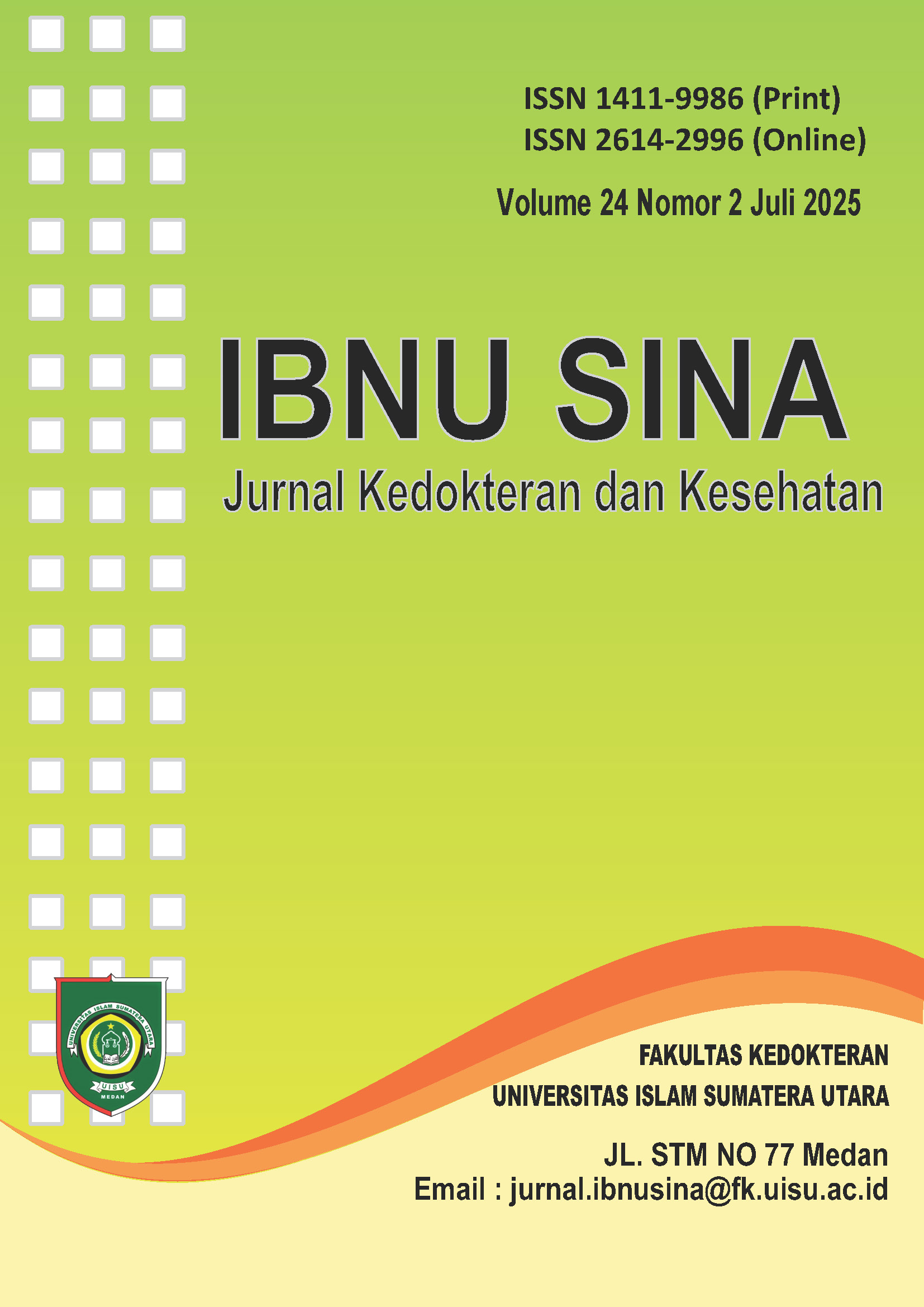PERAN RASIO LACTATE DEHIDROGINASE DAN LIMFOSIT SEBAGAI PENANDA EFUSI PLEURA MALIGNANSI
THE ROLE OF LACTATE DEHYDROGENASE AND LYMPHOCYTE RATIO AS MARKERS OF MALIGNANT PLEURAL EFFUSION
Abstract
Pendahuluan: Efusi pleura merupakan salah satugejala dari patologi yang mendasarinya. Pemeriksaan biokimia yang umumnya dilakukan untuk membedakan patologi tersebut adalah kadar laktat dehydrogenase, adenosine deaminase, dan limfosit. Tujuan: mengevaluasi penggunaan rasio LDH cairan pleura/limfosit dalam cairan pleura sebagai parameter baru untuk membedakan antara efusi pleura maligna dan bukan. Metode: Penelitian cross sectional di RSUP Dr. Mohammad Hoesin (RSMH) Palembang menggunakan rekam medis. Pasien dewasa dengan diagnosa efusi pleura eksudatif yang dilakukan pemeriksaan analisa cairan pleura libatkan dalam penelitian ini. Uji hipotesis dilakukan dengan menggunakan uji T tidak berpasangan atau uji Mann Whitney U. Hasil: Penelitian ini melibatkan 206 pasien, dimana 43,21% didiagnosis dengan efusi pleura non-malignansi, sedangkan 56,79% dengan efusi pleura malignansi. Pemeriksaan LDH cairan pleuradan limfosit cairan pleura menunjukkan perbedaan yang signifikan antara kelompok pasien dengan dan tanpa malignansi (LDH cairan pleurakelompok malignansi: 593,5 U/L [32 – 1.940] vs kelompok non-malignansi: 198 U/L [104 – 811], p < 0,001; limfosit kelompok non-malignansi: 87% [21-95] vs kelompok malignansi: 38% [30-93], p < 0,001). Rasio LDH cairan pleura terhadap limfosit juga menunjukkan perbedaan yang signifikan (kelompok malignansi: 15,18 [0,81-60,03] vs non-malignansi: 2,84 [1,15-22,87], p < 0,001). Kesimpulan: Terdapat perbedaan yang signifikan antara LDH cairan pleura, limfosit cairan pleura, dan rasio antara kedua antara pasien dengan efusi pleura maligna dan non-maligna.
References
Habas E, Rayani A, Alfitori G, et al. Malignant Pleural Effusion Pathophysiology, Causes, Epidemiology, and Therapies: Updates Review. Libyan Int J Oncol. Published online 2023:45–57.
Gayen S. Malignant pleural effusion: presentation, diagnosis, and management. Am J Med. 2022;135(10):1188–1192.
Jovanovic D. Etiopathogenesis of malignant pleural effusion. AME Med J. 2021;6.
Ferreiro L, Toubes ME, San José ME, Suárez-Antelo J, Golpe A, Valdés L. Advances in pleural effusion diagnostics. Expert Rev Respir Med. 2020;14(1):51–66.
Feller-Kopman DJ, Reddy CB, DeCamp MM, Al E. Management of Malignant Pleural Effusions: An Official ATS/STS/STR Clinical Practice Guideline. Am J Respir Crit Care Med. 2018;198(7):839–849.
National Comprehensive Cancer Network. NCCN Clinical Practice Guidelines in Oncology: Malignant Pleural Mesothelioma. NCCN; 2018.
Zhao T, Zhang J, Zhang X, Wang C. Clinical significance of pleural fluid lactate dehydrogenase/adenosine deaminase ratio in the diagnosis of tuberculous pleural effusion. BMC Pulm Med. 2024;24(1):241.
Hussein SA, Elhefnawy MY. Relations between serum and pleural fluid biomarkers: a new look of an old concept. Egypt J Bronchol. 2020;14(1):4. doi:10.1186/s43168-020-00004-3
Ho C-Y, Tsai Y-H, Chang C-C, et al. The role of pleural fluid lactate dehydrogenase-to-adenosine deaminase ratio in differentiating the etiology of pleural effusions. J Physiol Investig. 2022;65(3):105–108.
Khan SM, Emile SH, Wang Z, Agha MA. Diagnostic accuracy of hematological parameters in Acute mesenteric ischemia-A systematic review. Int J Surg. 2019;66:18–27. doi:10.1016/j.ijsu.2019.04.005
Vidal-Cevallos P, Higuera-De-La-Tijera F, Chavaz-Tapia NC, et al. Lactate-dehydrogenase associated with mortality in hospitalized patients with COVID-19 in Mexico: a multi-centre retrospective cohort study. Elsevier Sci Inc. 2021;24.
Verma A, Abisheganaden J, Light RW. Identifying Malignant Pleural Effusion by A Cancer Ratio (Serum LDH: Pleural Fluid ADA Ratio). Lung. 2016;194(1):147–153. doi:10.1007/s00408-015-9831-6
Lee SA, Kim SW, Chang HH, et al. A new scoring system for the differential diagnosis between tuberculous meningitis and viral meningitis. J Korean Med Sci. 2018;33(31):1–11. doi:10.3346/jkms.2018.33.e201
Verma A, Dagaonkar RS, Marshall D, Abisheganaden J, Light RW. Differentiating {Malignant} from {Tubercular} {Pleural} {Effusion} by {Cancer} {Ratio} {Plus} ({Cancer} {Ratio}: {Pleural} {Lymphocyte} {Count}). Can Respir J. 2016;2016:1–6. doi:10.1155/2016/7348239
De Fonseka D, Arnold DT, Morley AJ, et al. Lymphocyte predominance in blood, pleural fluid, and tumour stroma; a prognostic marker in pleural mesothelioma. BMC Pulm Med. 2022;22(1):173. doi:10.1186/s12890-022-01968-2
Suzuki K, Kadota K, Sima CS, et al. Chronic inflammation in tumor stroma is an independent predictor of prolonged survival in epithelioid malignant pleural mesothelioma patients. Cancer Immunol Immunother. 2011;60:1721–1728.
Yamada N, Oizumi S, Kikuchi E, et al. CD8+ tumor-infiltrating lymphocytes predict favorable prognosis in malignant pleural mesothelioma after resection. Cancer Immunol Immunother. 2010;59:1543–1549.
Copyright (c) 2025 Rouly Pola Pasaribu, Lia Damayanti

This work is licensed under a Creative Commons Attribution-ShareAlike 4.0 International License.



